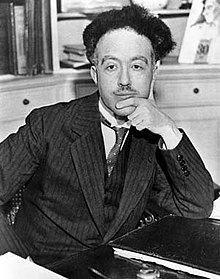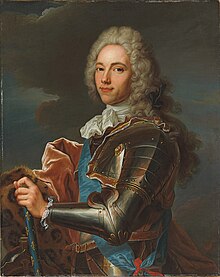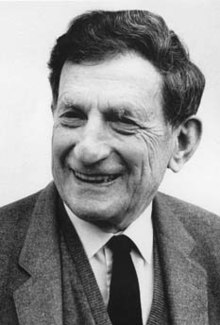Louis Victor Pierre Raymond, 7th Duc de Broglie (/də ˈbroʊɡli/,[1] also US: /də broʊˈɡliː, də ˈbrɔɪ/,[2][3] French: [də bʁɔj][4][5] or [də bʁœj] (listen); 15 August 1892 – 19 March 1987)[6] was a French physicist and aristocrat who made groundbreaking contributions to quantum theory. In his 1924 PhD thesis, he postulated the wave nature of electrons and suggested that all matter has wave properties. This concept is known as the de Broglie hypothesis, an example of wave–particle duality, and forms a central part of the theory of quantum mechanics.
Louis de Broglie | |
|---|---|
 Broglie in 1929 | |
| Born | 15 August 1892 Dieppe, France |
| Died | 19 March 1987 (aged 94) Louveciennes, France |
| Nationality | French |
| Alma mater | University of Paris (ΒΑ in History, 1910; BA in Sciences, 1913; PhD in physics, 1924) |
| Known for | Wave nature of electrons De Broglie–Bohm theory de Broglie wavelength |
| Awards | Nobel Prize in Physics (1929) Henri Poincaré Medal (1929) Albert I of Monaco Prize(1932) Max Planck Medal (1938) Kalinga Prize (1952) |
| Scientific career | |
| Fields | Physics |
| Institutions | University of Paris (Sorbonne) |
| Thesis | Recherches sur la théorie des quanta("Research on Quantum Theory") (1924) |
| Doctoral advisor | Paul Langevin |
| Doctoral students | Cécile DeWitt-Morette Bernard d'Espagnat Jean-Pierre Vigier Alexandru Proca Marie-Antoinette Tonnelat |

https://en.wikipedia.org/wiki/Louis_de_Broglie
David Joseph Bohm FRS[1] (/boʊm/; 20 December 1917 – 27 October 1992) was an American scientist who has been described as one of the most significant theoretical physicists of the 20th century[2] and who contributed unorthodox ideas to quantum theory, neuropsychology and the philosophy of mind.
Bohm advanced the view that quantum physics meant that the old Cartesian model of reality – that there are two kinds of substance, the mental and the physical, that somehow interact – was too limited. To complement it, he developed a mathematical and physical theory of "implicate" and "explicate" order.[3] He also believed that the brain, at the cellular level, works according to the mathematics of some quantum effects, and postulated that thought is distributed and non-localised just as quantum entities are.[4][failed verification]
Bohm warned of the dangers of rampant reason and technology, advocating instead the need for genuine supportive dialogue, which he claimed could broaden and unify conflicting and troublesome divisions in the social world. In this, his epistemology mirrored his ontology.[5] Due to his Communist affiliations, Bohm was the subject of a federal government investigation in 1949, prompting him to leave the United States. He pursued his scientific career in several countries, becoming first a Brazilian and then a British citizen. He abandoned Marxism in the wake of the Hungarian Uprising in 1956.[6][7]
Bohm's main concern was with understanding the nature of reality in general and of consciousness in particular as a coherent whole, which according to Bohm is never static or complete.[8]
David Bohm | |
|---|---|
 | |
| Born | December 20, 1917 |
| Died | October 27, 1992 (aged 74) London, England, UK |
| Nationality | American |
| Citizenship |
|
| Alma mater | |
| Known for |
|
| Awards | |
| Scientific career | |
| Fields | Theoretical physics |
| Institutions | |
| Doctoral advisor | Robert Oppenheimer |
| Doctoral students | |
| Influences | Albert Einstein Jiddu Krishnamurti |
| Influenced | John Stewart Bell, Peter Senge |
No comments:
Post a Comment